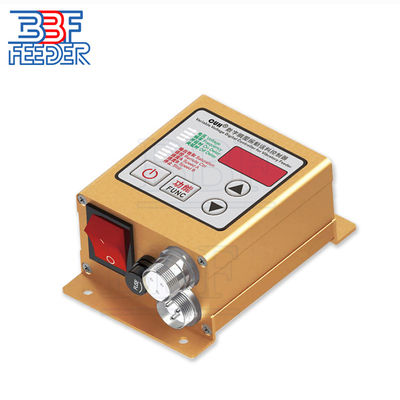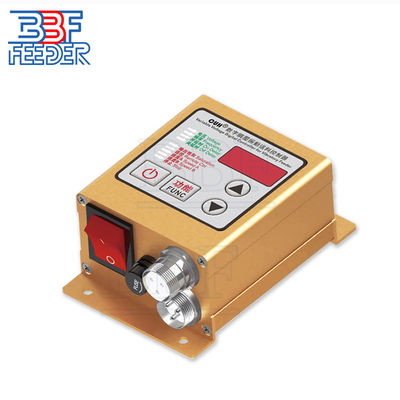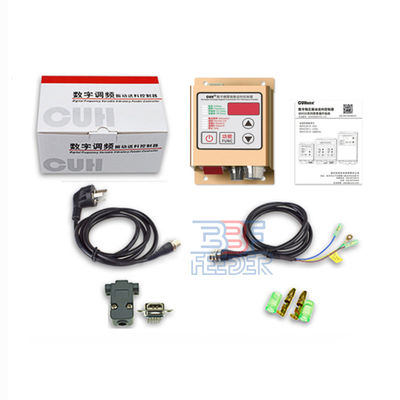Digital Vibratory Feeder Controller Digital Variable Frequency Controller
1 . Descriptions:
Vibratory bowl feeders are crucial in industrial manufacturing for drying, screening, and cooling individual component parts. Their primary function is to collect and transport these parts to the production line. The feeder system comprises various components like the base, hoppers, orienting rolls, and centrifeed units, which require vibration control. A vibratory bowl feeder controller is essential to regulate the speed of these components, as they would otherwise operate at their maximum speed. To accommodate variations in machine sequence rates, a variable controller is commonly employed.
The operation of a vibratory bowl feeder relies on the mechanical behavior of the parts. As the parts are gently shaken down a specially designed conveyor chute, they gradually interlock with one another. As manufacturing processes advance, the use of vibratory bowl feeders is sometimes reduced by incorporating mechanisms on tape packages that maintain the desired part orientation during transportation and storage. Vibrating conveyors consist of significant components such as a vibration damper, vibration motor, support base, trough, and other accessories.
Vibratory bowl feeders and their controllers find extensive usage in diverse manufacturing industries, including cosmetics, pharmaceuticals, electronics, automotive, food, fast-moving consumer goods, packaging, and metalworking. They also have applications in sectors like construction, foundries, steel mills, glass production, recycling, paper mills, and plastics manufacturing. These feeders provide a cost-effective alternative to manual labor, resulting in savings in time and labor costs for manufacturers. When selecting a parts feeder, it is vital to consider factors such as the industry, material properties, application, and product size.
2 . Specifications:
| Product Name |
Feeder Controller |
| Input Voltage |
85~260V |
| Output Voltage |
0-260V |
| Output Power |
0-1100VA |
| Output Frequency |
45-130HZ |
| On/Off Delay Time Rage |
0~9.9s |
| On/Off Delay Time Accuracy |
0.1s |
| Analog Control Signal |
1-5V |
| Digital Control Signal |
12V |
| Warranty |
1 Year
|
3 . Vibratory Bowl Feeder Controller:
Vibratory bowl feeders' controllers are highly sophisticated, reliable, useful, and robust units that are widely available in the market today. They provide the smoothest way of handling and sorting bulk products for further processing and packaging in a production line.
There are various types of vibratory bowl feeders' controllers, each with its own way of functioning and unique advantages and disadvantages. It is important to be familiar with these advantages and disadvantages to make an informed decision when selecting the appropriate controller. Some of the commonly used controllers include:
Electronic Voltage Controllers: These controllers regulate the voltage supplied to the vibratory bowl feeder, allowing precise control over the amplitude and intensity of the vibrations. They offer high accuracy and fine-tuning capabilities.
Analog Frequency Controllers: Analog frequency controllers adjust the frequency of the vibrations using analog signals. They are relatively simple to use and provide smooth control over the vibration frequency.
Digital Frequency Controllers: Digital frequency controllers use digital signals to adjust the vibration frequency. They offer precise control and can be easily programmed with different frequencies for specific applications.
Feedback Control: Feedback control systems use sensors to provide real-time feedback on the performance of the vibratory bowl feeder. The controller adjusts the vibrations based on this feedback, ensuring optimal performance and preventing issues such as overloading or jamming.
By understanding the characteristics and features of these different types of controllers, manufacturers can choose the most suitable option for their specific needs, optimizing the performance and efficiency of their vibratory bowl feeder systems.
4 . More Pictures:


 Your message must be between 20-3,000 characters!
Your message must be between 20-3,000 characters! Please check your E-mail!
Please check your E-mail!  Your message must be between 20-3,000 characters!
Your message must be between 20-3,000 characters! Please check your E-mail!
Please check your E-mail! 




